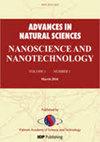Structural, spectroscopic and morphology studies on green synthesized ZnO nanoparticles
IF 2.1
Q3 MATERIALS SCIENCE, MULTIDISCIPLINARY
Advances in Natural Sciences: Nanoscience and Nanotechnology
Pub Date : 2023-06-16
DOI:10.1088/2043-6262/acd8b6
引用次数: 1
Abstract
Zinc oxide nanoparticles (ZnO NPs) were synthesised using Tabernaemontana divaricata flower extract (TFE) in different weight percentages by facile, eco-friendly and cost-effective green synthesis method. Formation and structure of the ZnO NPs were studied by powder XRD, FT−IR, Raman and TEM studies. The crystals formed are of hexagonal wurtzite structure with biological functional groups attached. Average crystallite size of the ZnO NPs (17.5−23.3 nm) was obtained from the analysis of powder XRD data which increased with increase of TFE amount while the estimated values of dislocation density and micro-strain exhibited an opposite behaviour. The optical (direct and indirect) energy band gap values estimated using UV–vis DRS spectral data decreased with increasing amount of TFE. The photoluminescence spectra for the ZnO NPs exhibited multiple peaks spread over the visible region with one peak in the NIR region indicating the existence of various defect levels of Zn and O. Position of these defect levels within the band gap was assigned which is significantly modulated by TFE. TFE amount-dependent peak shift and/or peak broadening were observed in the Raman spectra of the ZnO NPs which were correlated with the growing disorder in the crystals induced by the extract molecules. FESEM study showed the agglomerated NPs with quasi-spherical morphology. Particle size of the ZnO NPs was estimated from FESEM images. EDX study indicated that increased presence of TFE in ZnO decreased the oxygen content in the synthesised material. HRTEM study revealed the agglomeration of nanoparticles with single crystalline nature. Present study convincingly established that flower extract used for the green synthesis efficiently modified the structure and optical property, defect levels and morphology of the potentially useful ZnO nanoparticles.绿色合成ZnO纳米颗粒的结构、光谱和形貌研究
采用简单、环保、经济的绿色合成方法,以不同重量百分比的牛蒡花提取物为原料合成氧化锌纳米颗粒(ZnO NPs)。采用粉末XRD、FT - IR、Raman和TEM研究了ZnO纳米粒子的形成和结构。形成的晶体为六方纤锌矿结构,并附有生物官能团。粉末XRD数据分析得出ZnO纳米粒子的平均晶粒尺寸(17.5 ~ 23.3 nm)随TFE用量的增加而增大,而位错密度和微应变的估算值则相反。利用UV-vis DRS光谱数据估算的光学(直接和间接)能带隙值随着TFE用量的增加而减小。ZnO纳米粒子的光致发光光谱在可见光区呈多峰分布,其中近红外区有一个峰,表明锌和氧存在不同的缺陷水平,这些缺陷水平在带隙内的位置被TFE显著调制。在ZnO NPs的拉曼光谱中观察到与TFE量相关的峰移和/或峰展宽,这与萃取物分子诱导的晶体生长紊乱有关。FESEM研究表明,NPs具有准球形的团聚形态。通过FESEM图像估计ZnO纳米粒子的粒径。EDX研究表明,氧化锌中TFE含量的增加降低了合成材料中的氧含量。HRTEM研究表明,纳米颗粒的团聚具有单晶性质。本研究令人信服地证实,用于绿色合成的花提取物有效地改变了潜在有用的ZnO纳米颗粒的结构和光学性质,缺陷水平和形貌。
本文章由计算机程序翻译,如有差异,请以英文原文为准。
求助全文
约1分钟内获得全文
求助全文
来源期刊

Advances in Natural Sciences: Nanoscience and Nanotechnology
NANOSCIENCE & NANOTECHNOLOGYMATERIALS SCIE-MATERIALS SCIENCE, MULTIDISCIPLINARY
自引率
4.80%
发文量
0
 求助内容:
求助内容: 应助结果提醒方式:
应助结果提醒方式:


